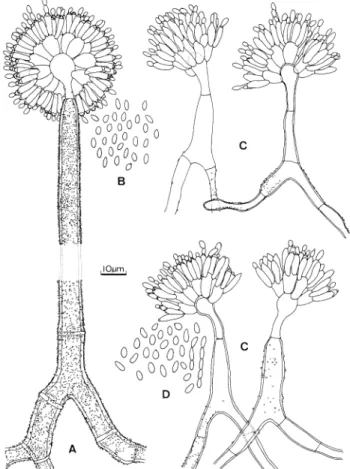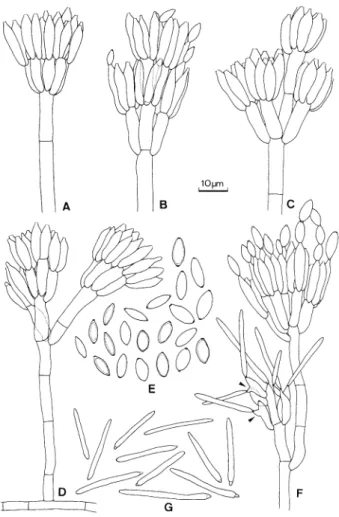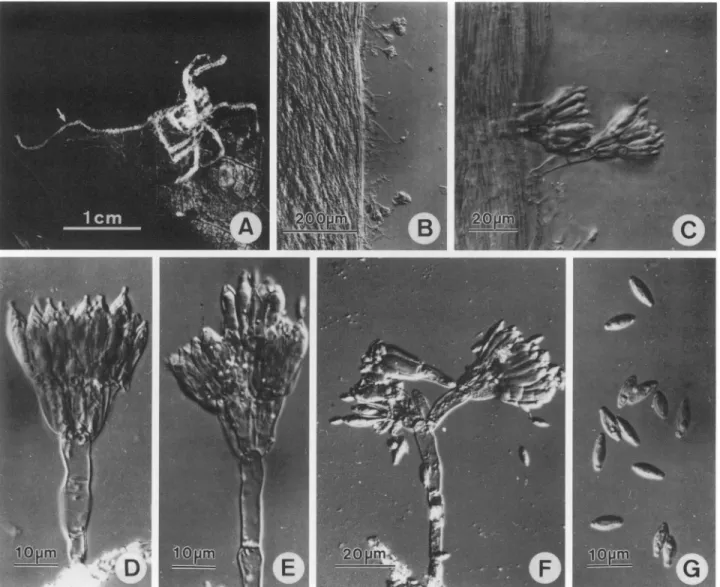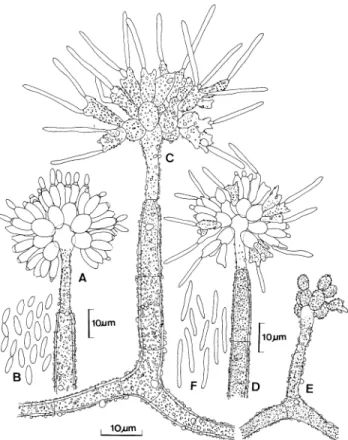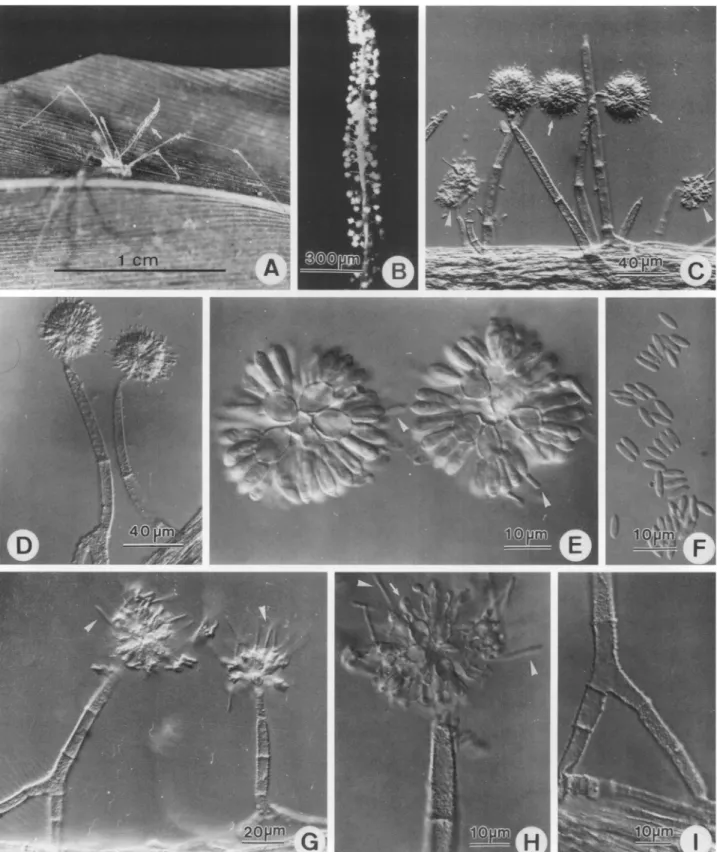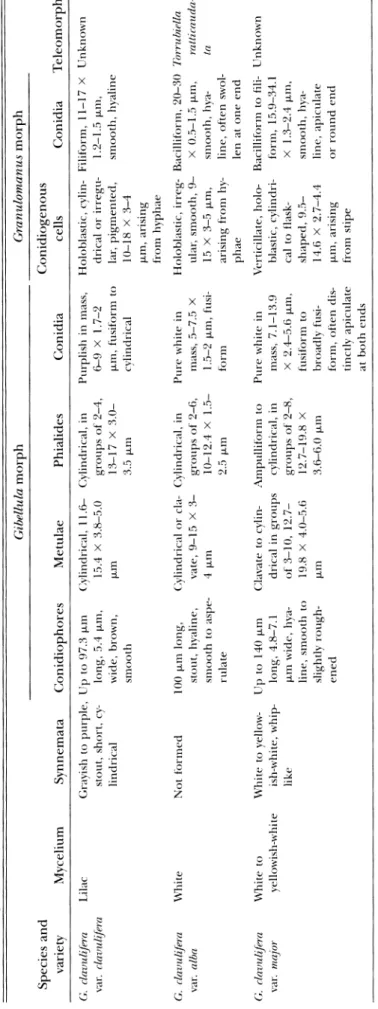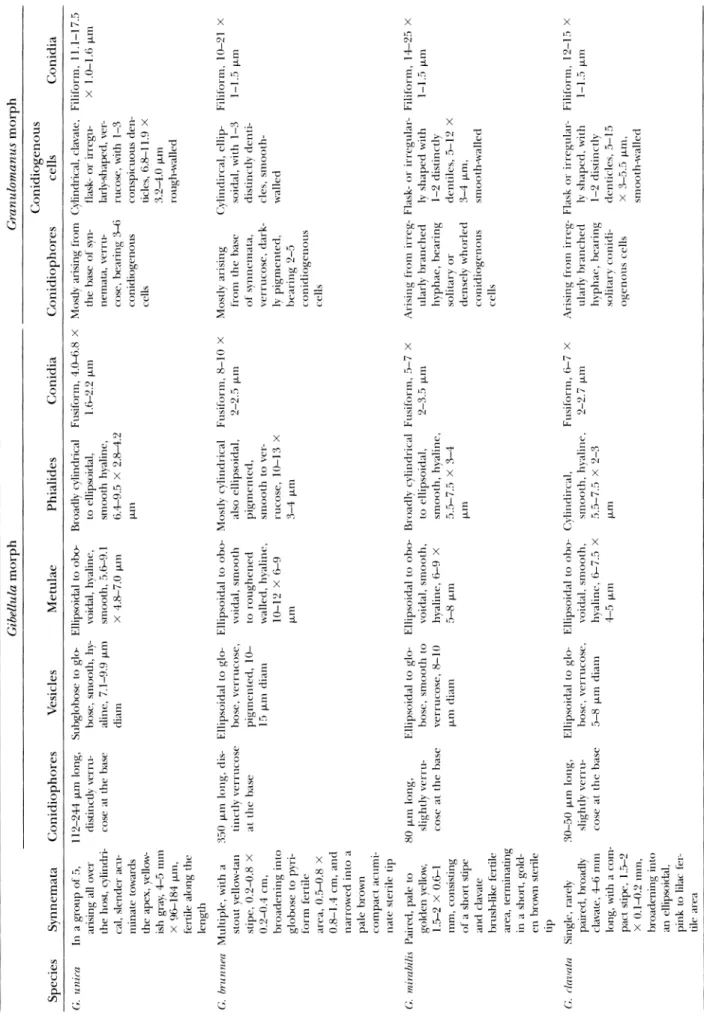Mycological Society of America
The Genus Gibellula on Spiders from Taiwan Author(s): S. S. Tzean, L. S. Hsieh, W. J. Wu
Source: Mycologia, Vol. 89, No. 2 (Mar. - Apr., 1997), pp. 309-318 Published by: Mycological Society of America
Stable URL: http://www.jstor.org/stable/3761088
Accessed: 28/01/2010 22:30
Your use of the JSTOR archive indicates your acceptance of JSTOR's Terms and Conditions of Use, available at
http://www.jstor.org/page/info/about/policies/terms.jsp. JSTOR's Terms and Conditions of Use provides, in part, that unless you have obtained prior permission, you may not download an entire issue of a journal or multiple copies of articles, and you may use content in the JSTOR archive only for your personal, non-commercial use.
Please contact the publisher regarding any further use of this work. Publisher contact information may be obtained at
http://www.jstor.org/action/showPublisher?publisherCode=mysa.
Each copy of any part of a JSTOR transmission must contain the same copyright notice that appears on the screen or printed page of such transmission.
JSTOR is a not-for-profit service that helps scholars, researchers, and students discover, use, and build upon a wide range of content in a trusted digital archive. We use information technology and tools to increase productivity and facilitate new forms of scholarship. For more information about JSTOR, please contact support@jstor.org.
Mycological Society of America is collaborating with JSTOR to digitize, preserve and extend access to Mycologia.
Mycologia, 89(2), 1997, pp. 309-318.
© 1997 by The New York Botanical Garden, Bronx, NY 10458-5126
The genus Gibellula on spiders from Taiwan
S. S. Tzean' L. S. Hsieh
W. J. Wu
Department of Plant Pathology and Entomology, National Taiwan University, Taipei, Taiwan 10617, Republic of China
Abstract: Four species of Gibellula were found on spiders in Taiwan. Gibellula leiopus and G. pulchra are redescribed; G. unica, a new species, and G. clavuli- fera var. major, a new variety, are described. A key to
the Taiwanese Gibellula species is given. The most dis- tinguishing feature of G. unica is the concurrent or independent production of phialidic or polyblastic conidiogenous cells of, respectively, Gibellula and Granulomanus synanamorphs on the same well dif- ferentiated distinctly verrucose conidiophore. Gibel- lula clavulifera var. major is primarily characterized by a white, solitary, whiplashlike synnema arising from the tip of host abdomen, and from which the bi-, ter-, or rarely monoverticillate penicilli are initi- ated. The verticillate conidiogenous cells on the well differentiated conidiophores are of two types, one phialidic bearing catenate, fusiform to broadly fusi- form conidia; the other holoblastic, with distinct den- ticles bearing solitary, long, bacilliform conidia. Gi- bellula unica is compared to the morphologically sim- ilar species G. brunnea, G. clavata, and G. mirabilis; and G. clavulifera var. major is compared to G. cla- vulifera var. clavulifera, and G. clavulifera var. alba.
Key Words: Araneae, Clavicipitales, Granuloman- us, Hyphomycetes, systematics, taxonomy, Torrubiella
INTRODUCTION
Spiders are naturally infected by a number of fungal pathogens, including species in the anamorph gen- era Akanthomyces Lebert, Clathroconium Samson & Evans, Engyodontium de Hoog, Gibellula Cavara, Granulomanus de Hoog, Hymenostilbe Petch, Nomu- raea Maublanc, Paecilomyces Bainier, Pseudogibellula Samson & Evans, and the teleomorph genus Torru- biella Boudier (Evans and Samson, 1987; Samson et
Accepted for publication October 15, 1996. 1 Corresponding author, email: sst@ccms.ntu.edu.tw
al., 1988). The mechanisms of infection and mortal- ity of the spiders by these pathogenic fungi are thought to be comparable to the mechanisms found in other other insect hosts (Evans and Samson, 1987). Since spiders are natural enemies of insect pests, mortality of spiders due to fungal infection may affect natural biocontrol of those pests, although the ecological significance of the spider mortality has not been comprehensively evaluated (Evans and Samson, 1987; Samson et al., 1988).
Among spider pathogens, the genus Gibellula was established by Cavara in 1894 to accommodate G. pulchra (Sacc.) Cavara because of its unusual coni- diogenous cells. Since then, a number of species have been described on spiders (Petch, 1932; Mains, 1950; Samson and Evans, 1973, 1977; Humber and Rom- bach, 1987). Four new species of Gibellula were de- scribed by Samson and Evans (1992) from infected spiders collected in South America. They thoroughly discussed the taxonomy, host specificity, habitats and teleomorph connections (Hoog, 1980; Humber and Rombach, 1987), and presented a key to the nine accepted Gibellula species.
In Far Eastern Asia, Sawada conducted an exten- sive study of the fungal flora of Formosa from 1915 to 1945. He described four new Gibellula species, in- cluding G. formosana Sawada on pupae of moth, G. araneicola Sawada, and G. araneae Sawada on spiders, and G. tropicalis Sawada on an unspecified insect that inhabited the underside of leaves (Sawada, 1919, 1928, 1959). Kao (1981) reported finding G. suffulta Speare on Araneae from Fujian, People's Republic of China. Gibellula suffulta was suggested to be synomyn of G. pulchra by Mains (1950).
During a survey of the insect- and spider patho- gens from Taiwan that has been in progress since 1989, a total of 47 spiders associated with Gibellula species were collected. Of them, 20 were identified as G. pulchra and one as G. leiopus (Vuill.) Mains. Two collections were reminiscent of G. clavuliferavar. alba Humber & Rombach in having white to yellow- ish white, solitary whiplike synnemata arising from the abdomen of host, and penicillately arranged con- idiogenous cells. They differed from this variety in having much larger, broadly fusiform conidia, and verticillate cylindrical to flask-shaped polyblastic con- idiogenous cells, and thus are the described as a new 309
MYCOLOGIA
FIG. 1. Characteristics of conidiophores, conidiogen-
ous cells, and conidia of Gibellula species. A, B. G. pulchra (Ar. 78). C, D. G. leiopus (Ar. 28).
variety (Humber and Rombach, 1987). Nine collec-
tions were similar to G. brunnea Samson & Evans. They differed from G. brunnea in gross morphology and pigmentation of synnemata, in the roughness of their conidiogenous cells, and particularly in the con- currence of phialidic and holoblastic conidiogenous cells on the same conidiophore (Samson and Evans, 1992). Because of these differences, they represent a new species.
Following is an account of the species of Gibellula for Taiwan. All herbarium specimens are deposited in the Plant Pathology and Entomology Department, National Taiwan University, Taipei, Taiwan, Republic of China. Kornerup and Wanscher (1978) were fol- lowed for color nomenclature.
DESCRIPTIONS OF THE SPECIES
Gibellula pulchra (Sacc.) Cavara, Atti Ist. Bot. Univ.
Pavia Ser II, 3: 347. 1894. FIG. 1 A, B Spider completely covered by a mat of white, yel- lowish white (4A2), pale, pastel to light or grayish yellow (2A3-4, 3A4-6, 3B5-6), occasionally orange
white, pale to light orange (5A2-4) mycelium. Syn- nemata solitary to numerous, arising from all parts of the host, cylindric, attenuated, 4-7 mm long, 120- 144 jLm diam, consisting of parallel multiseptate lon- gitudinal hyphae. Hyphae of synnemata hyaline, verrcuose, 3.2-5.5 jLm wide. Conidiophores greenish white to pale green (30A2-3), arising from the my- celium covering the host or from the synnemata, 110-640 X 7.9-10.3 jim, septa conspicuous, thick- ened and often darkly pigmented, distinctly rough- ened at the basal 3-5 cells, narrowing abruptly to a slender apex, 2.8-4.0 jLm wide, and terminating in a swollen vesicle. Conidial head 40-48 bjm diam. Vesi- cle mostly ellipsoidal to globose, 8.7-10.3 X 7.9-8.7 pjm. Phialides cylindrical to narrowly clavate, with a short neck, often apically thickened, hyaline, 6.4- 10.3 X 2.0-2.4 jLm, up to 10, borne on metulae. Me- tulae broadly obovoid, hyaline, 7.9-9.9 X 5.2-6.4 pjm, up to 20, borne on a vesicle. Conidia hyaline, ellip- soidal, sometimes fusoid, smooth, single or catenu- late, 4.0-6.0 X 2.0-2.4 jm. Teleomorph and Granu- lomanus synanamorphs not observed.
Specimens examined. REPUBLIC OF CHINA. TAI-
WAN: Ilan County, Yuanshan, Fushan Herbarium, on spider Ar 6, 9 Aug. 1989; Taipei County, Wulai, Hap- en, on spider Ar. 7, 9 Aug. 1989; Taichung County, Hoping, Tashueshan, on spider Ar. 9, 24 Oct. 1989; Nantou County, Wushe, on spider Ar. 10, 24 Oct. 1989; Pingtung County, Manchow, Nanjenshan, on spider Ar. 13, 24 Feb. 1990; Taipei County, Wulai, on spider Ar. 17, 1 Jun. 1990; Taipei City, Mientienshan, on spider Ar. 21, 12 Jun. 1990; Taipei City, Yang- mingshan National Park, on spider Ar. 27, 16 Aug. 1990; Nantou County, Puli, Lienhuachih, on spiders
Ar. 31, Ar 32, Ar 34, 29 Sep. 1990; Nantou County,
Luku, Chitou, on spider Ar. 38, 22 Dec. 1990; Nantou County, Puli, Lienhuachih, on spider Ar. 53, 10 Jul. 1991; Taitung County, Yenping, on spiders Ar. 62, Ar. 63, 30 Jul. 1991; Nantou County, Puli, Lienhuachih, on spider Ar 71, 9 Sep. 1994; Ilan County, Tatung, Taipingshan, on spider Ar 72, 28 Aug. 1993; Kao- hsiung County, Liukui, Shanping, on spider Ar 78, 22 Oct. 1994; Taipei County, Sanhsia, Manyuehyuan, on spider Ar. 97, 20 Jan. 1995; Pingtung County, Manchow, Nanjenshan, on spider Ar 102, 1 Mar. 1995.
Gibellula leiopus (Vuill.) Mains, Mycologia 42: 318.
1950. FIG. 1 C, D
Spider covered by dense white to yellowish white (3A2) mycelium. Synnemata arising from the whole host, erect, cylindrical, or slightly clavate, with a short stipe, white, becoming orange white to pale orange (5A2-3) in age, pulverulent when sporulating, 0.7- 310
TZEAN ET AL.: GIBELLULA ON SPIDERS
1.0 mm long, 280-430 JLm diam, composed of par- allel densely compact hyphae. Hyphae of synnemata septate, hyaline to yellowish white (2A2) to grayish yellow (1B3), mostly smooth, 1.8-4.8 pjm wide, but becoming arched, wider, and distinctly verrucose, near the points of origin of conidiophores. Conidi- ophores arising at the ends of hyphae of the synne- mata or laterally from the arched hyphae of the syn- nemata, crowded, especially on the upper portion, 24-80 X 4.4-11.1 !jm, mostly smooth, occasionally slightly verrucose at the base, narrowing to a slender apex, and terminating in a swollen vesicle. Conidial head wedge-shaped, hemispherical to spherical, (16-) 24-56 jim diam. Vesicle mostly ellipsoidal to globose, smooth, hyaline, 5.6-9.2 JLm diam, bearing a number of metulae on the upper portion. Metulae ellipsoidal, broadly cylindrical to obovoidal, hyaline, smooth, 7.5-10.7 X 3.7-6.4 jim, bearing up to 13 phialides at the apices. Phialides narrowly clavate to subcylindri- cal, tapering towards the thickened apex, smooth, hy- aline, 7.9-11.5(-14.0) X 2.4-3.4 jim. Conidia mostly ovoid, ellipsoidal, often cylindrical to fusiform, some- times obclavate, occasionally apiculate, hyaline, smooth, single or in a long chains, 3.0-5.4 X 1.6-2.5
i.m.
Specimen examined. REPUBLIC OF CHINA. TAI- WAN: Taipei City, Yangmingshan National Park, on spider Ar 28, 16 Aug. 1990, W. J. Wu.
Gibellula clavulifera var. major Tzean, Hsieh, Liou, et Wu, var. nov. FIGS. 2, 3
Mycelium hospitem cooperiens, album vel flavido- album. Synnemata solitaria, alba vel flavido-alba, dor- so abdominis hospitis enata, exilia, cylindrica, apicem versus aliquando arcuata, 10-15 mm longa, 400-500
jLm lata, e fascibus compactis hyphas parallelas con- tientibus constantia. Conidiophora proxime aut e my- celio, aut ex apice aut e latere synnematum orientia, hyalina, penicillata, plerumque bi- vel triverticillata, raro univerticillata, robusta, glabra vel subaspera, 140
jtm longa, 4.8-7.1 tjm lata. Vesiculae absentes vel ae- gre effectae. Rami cylindrici, aliquando septati, 25.0- 34.0 X 4.8-6.0 jLm. Ramuli cylindrici 15.9-20.6 X 4.4-6.4 jLm, metulas 3-10 gerentes. Metulae clavatae vel cylindricae, 12.7-19.8 X 4.0-5.6 txm, phialides 2-8 gerentes . Phialides ampulliformes vel cylindri- cae, 12.7-19.8 X 3.6-4.8(-5.3) jim, in apice exigue incrassatae, collis indistinctis praeditae vel collis car- entes. Conidia catenata, hyalina, exigue crassitunica- ta, 7.1-12.0(-13.9) X 2.4-4.0(-5.6) jLm, unicellularia, late fusiformia vel fusiformia, aut apiculata aut in po- lis exigue rotundata. Status Granulomanus synana- morphicus adest. Conidiophora e stipite synanamor- phae Gibellula orientia, hyalina, glabra vel leviter as-
FIG. 2. Gibellula clavulifera var. major. Characteristics of conidiophores, conidiogenous cells and conidia in the syn- anamorphs. A-E. Gibellula stage. F, G. Granulomanus stage. Distinct denticles on holoblastic conidiogenous cells indi- cated by arrow heads. (F). On spider Ar 76.
pera, cellulas conidiogenas in apice verticillatas ho- loblasticas gerentia. Cellulae conidiogenae cylindricae vel ampulliformes, denticulis 1-2 conspicuis armatae, 9.5-14.6 X 2.7-4.4 jLm, conidio unico ex omne den- ticulo oriente instructae. Conidia prosenchymata, fil- iformia vel bacilliformia, 15.9-26.2(-34.1) X 1.3-2.4
jLm, interdum in polo uno subtumida apiculataque, unicellularia glabritunicata, hyalina. Status teleomor- phicus ignotus.
HOLOTYPUS. REPUBLIC OF CHINA. TAIWAN: Kaohsiung County, Liukui, Sanping, on spiders, Ar.
76, Ar. 88, 22 Oct. 1994, J. Y Liou (PPH 25, depos- ited in Department of Plant Pathology and Entomol- ogy, National Taiwan University, Taipei, Taiwan, Re- public of China).
Mycelium covering the host, white to yellowish white (4A2). Synnemata solitary, white to yellowish white (4A2), arising from the posterior of the host abdomen, slender, cylindrical, sometimes curved to- wards the end, 10-15 mm long, 400-500 am wide,
MYCOLOGIA
FIG. 3. Gibellula clavulifera var. major. A. Habit. A solitary synnema arising from the tip of the abdomen of the infected
spider (arrow head). B. Synnema composed of compact parallel hyphae. C. Penicillate conidiophores arising from the synnema. D, E. Biverticillate conidiophore and conidiogenous cells. F. Terverticillate conidiophore. G. Conidia.
consisting of a compact bundle of parallel hyphae. Conidiophores directly arising from aerial mycelium, or apically or laterally from synnemata, hyaline, most- ly biverticillate or terverticillate, occasionally monov- erticillate, stout, smooth or slightly roughened, to 140 ,xm long, 4.8-7.1 ,um wide. Vesicles absent or hardly developed. Rami cylindrical, sometimes sep- tate, 25.0-34.0 x 4.8-6.0 ,im. Ramuli cylindrical, 15.9-20.6 X 4.4-6.4 ,jm, bearing 3 to 10 metulae. Metulae clavate to cylindrical, 12.7-19.8 X 4.0-5.6 jLm, bearing 2 to 8 phialides. Phialides ampulliform to cylindrical, 12.7-19.8 X 3.6-4.8(-5.3) ,um, apex slightly thickened, neck absent or indistinct. Conidia in chains, hyaline, slightly thick-walled, 7.1-12.0
(-13.9) X 2.4-4.0(-5.6) jLm, one-celled, broadly fu- siform to fusiform, either apiculate or with slightly rounded ends. Granulomanus synanamorph present.
Conidiophores arising from the stipe of Gibellula syn- anamorph, hyaline, smooth or inconspicuously roughened, bearing apically whorled polyblastic con- idiogenous cells. Conidiogenous cells cylindrical to flask-shaped, with one to two conspicuous denticles, 9.5-14.6 X 2.7-4.4 jxm, each denticle giving rise to a solitary conidium. Conidia filiform to bacilliform, 15.9-26.2(-34.1) X 1.3-2.4 jim, sometimes slightly swollen and apiculate at one end, one-celled, smooth, hyaline. Teleomorph not observed.
Gibellula unica Tzean, Hsieh et Wu, sp. nov. FIGS. 4, 5 Hospes arachnoideus tegete alba myceliali coopertus. Synnemata catervas 5-6 formantia, proxime e latere dorsali hospitis orientia, exilia, cylindrica, attenuata, flavido-grisea (4B2), 4-5 mm longa, 96-184 Ixm lata, e hyphis dense com- 312
I
•,.. t , " ,I 11 . : - . -v '.. . S::L . . . ..,
W,i
TZEAN ET AL.: GIBELLULA ON SPIDERS
FIG. 4. Gibellula unica. Characteristics of conidiophores, conidiogenous cells, and conidia in the synanamorphs. A, B. Gibellula stage. C-F. Granulomanus stage. On spider Ar. 55.
pactis parallelis constantia. Hyphae hyalinae, verrucosae, 3.2-6.1 tim latae. Conidiophora hyalina, septata, synnema- tibus enata, dispersa vel dense compacta, 112-244 ptm lon- ga, 6.4-13.5 tim lata, longitudinaliter aspera, in apicem gra- cilem abrupte decrescentia, diametro 2.4-4.0 tm, in vesciculam inflatam terminantia. Capitulum conidicum dia- metro 40-52 tLm . Vesicula ellipsoida, subglobosa vel glo- bosa, glabritunicata, interdum subverrucosa, hyalina, 7.1- 9.9 X 5.6-7.9 tLm. Phialides late cylindricae vel ellipsoideae, glabritunicatae, raro asperae, colo brevi praeditae, pler- umque in apice incrassatae, hyalinae, 6.4-9.5 X 2.8-4.2 tLm, in verticillum ex phialidibus 3-12 compositum dispositae, in metulis portatae. Metulae late ellipsoideae, obovoideae, hyalinae, glabritunicatae, interdum 5.6-9.1 X 4.8-7.0 tim. Conidia fusiformia, interdum apiculata, hyalina, glabritun- icata, brevicatenata, 4.0-6.8 X 1.6-2.2 tim. Cellulae coni- diogenae synanamorphae Granulomanus holoblasticae, cy- lindricae, clavatae, ampullaecae vel in ambitu irregulares, maximam partem verrucosae, raro glabrae, denticulis con- spicuis 1-3 armatae, 6.8-11.9 X 3.2-4.0 tLm, conidia soli- taria, longa, filiformia gerentes. Conidia glabritunicata, hy- alina, 11.1-17.5 X 1.0-1.6 tpm. Status teleomorphicus ig- notus.
HOLOTYPUS. REPUBLIC OF CHINA. TAIWAN: Nan- tou County, Puli, Lienhuachih, on a spider Ar. 55, 10 July, 1992, L. S. Hsieh (PPH 23, deposited in Department of
Plant Pathology and Entomology, National Taiwan Univer- sity, Taipei, Taiwan, Republic of China).
Spider host covered by white mycelial mat. Synnemata in groups of 5 or 6, arising directly from the dorsal side of the host, slender, cylindrical, attenuated, yellowish gray (4B2), 4-5 mm long, 96-184 jim wide, composed of parallel, densely compacted hyphae. Hyphae of synnemata hyaline, verrucose, 3.2-6.1 Kpm wide. Conidiophores hyaline, sep- tate, arising from arches in hyphae of the aerial mycelium or from synnemata, scattered or densely compacted, 112- 244 tLm long, 6.4-13.5 Kim wide, distinctly roughened along the length, narrowing abruptly to a slender apex, 2.4-4.0 Kim diam and terminating in a swollen vesicle. Conidial head 40-52 tLm diam. Vesicle ellipsoidal, subglobose to glo- bose, smooth, occasionally slightly verrucose, hyaline, 7.1- 9.9 X 5.6-7.9 tLm. Phialides broadly cylindrical to ellipsoid- al, smooth, rarely roughened, with a short neck, often api- cally thickened, hyaline, 6.4-9.5 X 2.8-4.2 tm, in a whorl of 3-12, borne on metulae. Metulae broadly ellipsoidal, obovoidal, hyaline, smooth, occasionally 5.6-9.1 X 4.8-7.0 tLm. Conidia fusiform, occasionally apiculate, hyaline, smooth, in short chains, 4.0-6.8 X 1.6-2.2 im. Conidio- phores of Granulomanus synanamorph present, well differ- entiated, roughened to distinctly verrucose, particularly around the base of the synnemata. Conidiogenous cells of
Granulomanus synanamorph holoblastic, cylindrical, cla- vate, flask-shaped, to irregularly shaped, mostly verrucose, rarely smooth, with one to three conspicuous denticles, 6.8- 11.9 X 3.2-4.0 tLm, bearing solitary, long, filiform conidia. Conidia smooth, hyaline, 11.1-17.5 X 1.0-1.6 tLm. Teleo- morph not observed.
DISCUSSION
Gibellula species associated with spiders were not un- common, particularly in humid and shaded areas. Usually the infected spider cadavers were collected from the lower side of broad leaved shrubs at eleva- tions of 200 to 2500 m. Of the 47 specimens of Gibel- lula species associated with spiders, G. pulchra was the predominant species encountered in all seasons and habitats. Gibellula leiopus was recorded only once in our survey in Taiwan, and was considered to be rare. Gibellula suffulta, which was recorded from Fujian (People's Republic of China) by Kao (1981), resem- bled G. leiopus in its conidiogenous strucures and very short conidiophores. Sawada described four new spe- cies of Gibellula from Taiwan, unfortunately type spec- imens are not available (Sawada, 1919, 1928, 1959; Ko- bayasi and Shimizu, 1976). However, judging from their illustrations and diagnoses, these four species are either synonymous with previously described Gibellula species, or can be excluded from Gibellula. Gibellula formosana Sawada is probably conspecific with Paeci- lomyces tenuipes (Petch) Samson, G. tropicalis Sawada is a synonym of G. pulchra, and G. araneae Sawada is a typical G. leiopus. No illustration was provided for G. 313
MYCOLOGIA
FIG. 5. Gibelluta unica. A. Habit. A synnema (arrow) arising directly from the abdomen of host. B. Conidiophores dis- persed along the whole length of the synnema. C. Gibellula (arrows) and Granulomanus (arrow heads) synanamorphs located near the base of the synnema. D-F. Gibellula synanamorph, conidiophores and conidiogenous cells and conidia. D. Conidi- ophores with globose conidial heads are conspicuously warted. E. Vesicles bearing metulae and phialides. Conidial initials indicated by arrow heads. F. Conidia. G-I. Granulomanus synanamorph. G. The distinctly roughened conidiophores bearing conidial heads and filiform conidia (arrow heads). H. Conidiogenous cells of Gibellula and Granulomanus synanamorphs concurrently initiated on the vesicle of the same conidiophore, bearing fusiform (arrow) and filiform (arrow heads) conidia. I. Conidiophore with distinct septation and arched base.
_ ..~%:...,...:... .. .-.~,.9~.~,. . .
_t_
__v~~~~~~~~~~~~2H
....
iSl 2
_
_ . . .
;
5
s
e
_a~~~~~~~~~~~~~~~~~~~~~~~~~~~~~~~~~~~~~~~~~~~~~~~~~~~~~~~~~~~~~
_[_E
_~ ~~~~~~~~~~~~~~~~~~~~~~. '| G
314 .. v-,,w. v. .-'"-. ... ' .... ... L- ; . ._.. ., - . - .. . .. I_TABLE I. Comparison of three varieties of Gibellula clavulifera with penicillate conidiophoresa
Gibellula morph Granulomanus morph
Species and Conidiogenous
variety Mycelium Synnemata Conidiophores Metulae Phialides Conidia cells Conidia Teleomorph
G. clavulifera Lilac Grayish to purple, Up to 97.3 p.m Cylindrical, 11.6- Cylindrical, in Purplish in mass, Holoblastic, cylin- Filiform, 11-17 x Unknown var. clavulifera stout, short, cy- long, 5.4 tlm, 15.4 X 3.8-5.0 groups of 2-4, 6-9 X 1.7-2 drical or irregu- 1.2-1.5 pim,
lindrical wide, brown, Lrm 13-17 X 3.0- ptm, filsiform to lar, pigmented, smooth, hyaline
smooth 3.5 pLm cylindrical 10-18 X 3-4
ptm, arising from hyphae
G. clavulifera White Not formed 100 p.m long, Cylindrical or cla- Cylindrical, in Pure white in Holoblastic, irreg- Bacilliform, 20-30 Torrubiella var. alba stout, hyaline, vate, 9-15 X 3- groups of 2-6, mass, 5-7.5 X ular, smooth, 9- X 0.5-1.5 pLm, ratticauda
smooth to aspe- 4 pLm 10-12.4 X 1.5- 1.5-2 Lmn, fusi- 15 X 3-5 p.m, smooth, hya- ta
rulate 2.5 p.om form arising from hy- line, often swol-
phae len at one end
G. clavulifera White to White to yellow- Up to 140 pLm Clavate to cylin- Ampulliform to Pure white in Verticillate, holo- Bacilliform to fili- Unknown var. major yellowish-white ish-white, whip- long, 4.8-7.1 drical in groups cylindrical, in mass, 7.1-13.9 blastic, cylindri- form, 15.9-34.1
like pLm wide, hya- of 3-10, 12.7- groups of 2-8, X 2.4-5.6 Limn, cal to flask- X 1.3-2.4 pm, line, smooth to 19.8 X 4.0-5.6 12.7-19.8 X fusiform to shaped, 9.5- smooth, hya- slightly rough- pIm 3.6-6.0 pLm broadly fusi- 14.6 X 2.7-4.4 line, apiculate
ened form, often dis- p.m, arising or round end
tinctly apiculate from stipe at both ends
a Data compiled in part from Samson and Evans (1977, 1992) and Humber and Rombach (1987).
H-
N
z
-I
TABLE II. Comparison of the morphological characters of Gibellula unica and related speciesa
Gibellula morph Granulomanus morph
Conidiogenous
Species Synnemata Conidiophores Vesicles Metulae Phialides Conidia Conidiophores cells Conidia G. unica In a group of 5, 112-244 pxm long, Subglobose to glo- Ellipsoidal to obo- Broadly cylindrical Fusiform, 4.0-6.8 X Mostly arising from Cylindrical, clavate, Filiform, 11.1-17.5
arising all over the host, cylindri- cal, slender acu- minate towards the apex, yellow- ish gray, 4-5 nmm
x 96-184 .nm,
fertile along the length
G. brunnea Multiple, with a
stout yellow-tan stipe, 0.2-0.8 x 0.2-0.4 cm, broadening into globose to pyri- form fertile area, 0.5-0.8 X 0.8-1.4 cm, and narrowed into a pale brown compact acumi- nate sterile tip G. mirabills Paired, pale to
golden yellow, 1.5-2 X 0.6-1 mm, consisting of a short stipe and clavate brush-like fertile area, terminating in a short, gold- en brown sterile tip
G. clavata Single, rarely
paired, broadly clavate, 4-6 mm long, with a com- pact stipe, 1.5-2 X 0.1-0.2 mm, broadening into an ellipsoidal, pink to lilac fer- tile area
bose, smooth, hy- voidal, hyaline, aline, 7.1-9.9 pLni smooth, 5.6-9.1
diam x 4.8-7.0 pULm Ellipsoidal to obo- voidal, smooth to roughened walled, hyaline, 10-12 X 6-9 pam Ellipsoidal to obo- voidal, smooth, hyaline, 6-9 X 5-8 p.m Ellipsoidal to obo- voidal, smooth, hyaline, 6-7.5 x 4-5 pIm
350 p.m long, dis- Ellipsoidal to glo- tinctly verrucose bose, verrucose, at the base pigmented, 10-
15 ,im diam
80 .m long, slightly verrtu- cose at the base
30-50 pLm long, slightly verru- cose at the base
Ellipsoidal to glo- bose, smooth to verrtucose, 8-10 p.m diamn Ellipsoidal to glo- bose, verrucose, 5-8 .mn diaim to ellipsoidal, 1.6-2.2 min smooth hyaline, 6.4-9.5 X 2.8-4.2 p.m
Mostly cylindrical Flusiform, 8-10 X also ellipsoidal, 2-2.5 pam
pigmented,
smooth to ver- rucose, 10-13 X
3-4 p.m
the base of syn- flask- or irregu- nemata, verru- larly-shaped, ver- cose, bearing 3-6 rucose, with 1-3 conidiogenous conspicuous den- cells ticles, 6.8-11.9 X 3.2-4.0 ptm rough-walled Cylindircal, ellip- soidal, with 1-3 distinctly denti- cles, smooth- walled Mostly arising from the base of synnemata, verrucose, dark- ly pigmented, bearing 2-5 conidiogenous cells x 1.0-1.6 pm Filiforml, 10-21 X 1-1.5 prm
4
r<, 25z
C ©^ Broadly cylindrical to ellipsoidal, smooth, hyaline, 5.5-7.5 x 3-4 prm Fusiform, 5-7 X 2-3.5 pLm Cylindircal, Ftusiformi, 6-7 X smooth, hyaline, 2-2.7 p.m 5.5-7.5 x 2-3 pmArisiing from irreg- Flask- or irregular- Filiform, 14-25 X ularly branched ly shaped with 1-1.5 pm hyphae, bearing 1-2 distinctly
solitary or dentiles, 5-12 X densely whorled 3-4 p.m, conidiogenous smooth-walled cells
Arising from irreg- ularly branched hyphae, bearing solitary conidi- ogenous cells
Flask or irregular- Filiform, 12-15 X ly shaped, with 1-1.5 pLm 1-2 distinctly
denticles, 5-15 X 3-5.5 p.m,
smooth-walled
1 Data compiled in part from Samson and Evans (1992).
distinctly verru-
TZEAN ET AL.: GIBELLULA ON SPIDERS
araneicola Sawada and its diagnosis is not adequate to characterize it. However its entomopathogenic habit indicates that it is probably not a Gibellula species, but perhaps a species of Paecilomyces Bainier.
Gibellula clavulifera is the only Gibellula species on spiders known to produce penicillately branched co- nidiophores. Its three varieties, vars. clavulifera, alba, and major, are distinguished through microscopic and macroscopic characters (TABLE I). Varieties clavulifera and major produce synnemata whereas var. alba is the only known Gibellula that does not form synnemata. Gibellula clavulifera var. alba is recognized most readily by the rat-tail like stroma that arises from the posterior tip of the host's abdomen (Humber and Rombach, 1987). Of the three varieties, only var. alba has been linked to a teleomorph, Torrubiella ratticaudata Hum- ber & Rombach (Humber and Rombach, 1987).
In its microscopic characters, G. unica resembles G. brunnea, G. clavata, and G. mirabilis (TABLE II).
However, these Gibellula species are easily separated through their synnemata (TABLE II). It is particularly
worth noting that G. unica and G. brunnea are the only species known to produce polyblastic, denticu- late conidiogenous cells on well-differentiated conid- iophores (TABLE II). Also G. unica is the only species that produces Gibellula and Granulomanus conidi- ogenous cells, respectively, enteroblastic and appar- ently holoblastic, on the same vesicle of a conidio- phore (FIG. 4 D).
Attempts to culture G. pulchra, G. leiopus, G. un- ica, and G. clavulifera var. major collected in Taiwan from single or mass conidia or mycelium on artifi- cial media [potato dextrose agar, 2% malt extract agar, or Sabouraud dextrose agar + 1 % yeast extract (SDAY) at 25°C in darkness] failed. Most attempts at culturing Gibellula species have not been successful, indicating that they may have specialized growth re- quirements (Samson and Evans, 1992). However, Gi- bellula clavulifera var. clavulifera from Ghana, and G. pulchra from Ecuadorian and Brazilian speci- mens have been grown on mealworm agar or gen- eral culture media (Samson and Evans, 1992). Their growth was slow and produced only rudimentary synnemata. Gibellula clavulifera var. alba (teleo- morph Torrubiella ratticaudata), from the Solomon Islands, was isolated on SDAY by Humber and Rom- bach (1987). It sparsely produced penicilloid conid- iophores, holoblastic, denticulate polyblastic coni- diogenous cells, and a limited number of ovoid, fu- siform to bacilliform conidia of Gibellula and Gran- ulomanus synanamorphs.
KEY TO THE GIBELLULA SPECIES FROM TAIWAN
1. Conidiophores penicillate; synnemata white, whip- lashlike, arising from the tip of host abdomen ...
... Gibellula clavulifera var. major 1. Conidiophores aspergillate; synnemata yellowish,
pale orange or grayish purple, multiple, cylindrical, arising from all over the host ... 2 2. Sporulating structures consisting of Gibellula and
Granulomanus morphs ... Gibellula unica 2. Sporulating structures consisting of Gibellula
morph only ... 3 3. Conidiophores 24-80 jLm long, mostly smooth, rarely
verrucose at the base ... Gibellula leiopus 3. Conidiophores 110-640 jIm long, distinctly rough-
ened, prominently verrucose at the base ...
... Gibellula pulchra
ACKNOWLEDGMENTS
The research was supported by grants from the National Science Council (NSC-84-0409-B002-129) and Council of Agriculture, Executive Yuan (84 Ko-Chi-1.3-Liang-31(8-2), R. 0. C. The authors thank J. Y Liou and C. F. Hwang for the technical assistance. Especial thanks are due to Drs. W. Gams, R. A. Humber, N. L. Hywel-Jones, A. Y Rossman, and G. J. Samuels for critical reviews of the manuscript and con- structive comments; and Dr. W. Gams and Mr. P. M. Eckel for preparation of the Latin diagnosis.
LITERATURE CITED
Cavara, F. 1894. Ulteriore contribuzione alla micologcia Lombarda. Atti Ist. Bot. Univ. Pavia Ser II, 3: 313-350. Evans, H. C., and R. A. Samson. 1987. Fungal pathogens
of spiders. The Mycologist 1: 152-159.
Hoog, G. S. de. 1980. Notes on some fungicolous Hypho- mycetes and their relatives. Persoonia 10: 33-81. Humber, R. A., and M. C. Rombach. 1987. Torrubiella rat-
ticaudata sp. nov. (Pyrenomycetes: Clavicipitales) and other fungi from spiders on the Solomon Islands. My- cologia 79: 375-382.
Kao. R. 1981. Description of a parasitic fungus Gibellula suffulta on spiders in Fujian. Acta Microbiologica Sinica 21: 308-310.
Kobayasi, Y, and D. Shimizu. 1976. Some species of Cor- dyceps and its allies on spiders. Kew Bulletin 31: 557- 566.
Kornerup, A., andJ. H. Wanscher. 1978. Methuen handbook of colour. Eyre Methuen Ltd., London, United King- dom. 252 pp.
Mains, E. B. 1950. The genus Gibellula on spiders in North America. Mycologia 42: 306-321.
Petch, T. 1932. Gibellula. Ann. Mycol. 30: 386-393. Samson, R. A., and H. C. Evans. 1973. Notes on entomo-
genous fungi from Ghana I. The genera Gibellula and Pseudogibellula. Acta Bot. Neerl. 22: 522-528.
, and . 1977. Notes on entomogenous fungi from Ghana IV. The genera Paecilomyces and Nomu- raea. Proc. Kon. Ned. Akad. Wetensch. Ser. C. 80: 128- 134.
, and . 1992. New species of Gibellula on spi-
318 MYCOLOGIA ders (Araneida) from South America. Mycologia 84:
300-314.
, , and J. P. Latge. 1988. Atlas of entomopath- ogenic fungi. Springer-Verlag, Berlin, Germany. 187 PP.
Sawada, K. 1919. Descriptive catalogue of the Formosan fungi. Vol. I. Bull. Agric. Exp. Sta. Formosa. p. 684.
. 1928. Descriptive catalogue of the Formosan fungi. Vol. IV. Bull. Agric. Exp. Sta. Formosa. p. 114.
. 1959. Descriptive catalogue of the Taiwan (Formosan) fungi. Vol. XI. National Taiwan Univ. Press, Taipei, Tai- wan, R. 0. C. p. 231.
